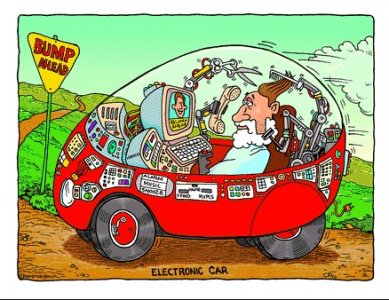You are using an out of date browser. It may not display this or other websites correctly.
You should upgrade or use an alternative browser.
You should upgrade or use an alternative browser.
Dumb questions about electric cars.
- Thread starter fuzzybuddy
- Start date
Dumb questions about electric cars.
Is it true, that when we go for a 200 mile drive, we would need to take a 200 mile electric extention cable with one end plugged in at home?

bobcat
Well-known Member
- Location
- Northern Calif
squatting dog
Remember when... thirty seemed so old.
- Location
- Arkansas, and also Florida
Mobilman44
Member
After 40 years in the "oil bizzness", and living here in Texas since the '70s, I'm obviously a bit biased about EVs. But I'll try to be objective here.
- EVs do have their place such as local business vehicles or short regular commutes. Taking trips that stretch the range is a bit risky, unless you are certain of the charging facilities.
- There are different levels of charging stations, from the home 110 v to home 220 v all the way up to the Tesla type charging depots. Charging away from home can be time consuming, charging at home can take several hours, depending on the type vehicle and electric facility.
- EVs can be dangerous, and a vehicle fire can typically not be put out. I saw one at a faulty charging facility, and the firemen just couldn't do more but contain it.
- I don't know about your location, but here in the north Houston area power outages happen more than you could imagine, and storms can knock out charging facilities for days. Obviously you can store gasoline for emergency use, but you can't store electricity (for EV use).
IMO, for personal use, you are much better off getting a hybrid vehicle before you jump into a full electric one.
- EVs do have their place such as local business vehicles or short regular commutes. Taking trips that stretch the range is a bit risky, unless you are certain of the charging facilities.
- There are different levels of charging stations, from the home 110 v to home 220 v all the way up to the Tesla type charging depots. Charging away from home can be time consuming, charging at home can take several hours, depending on the type vehicle and electric facility.
- EVs can be dangerous, and a vehicle fire can typically not be put out. I saw one at a faulty charging facility, and the firemen just couldn't do more but contain it.
- I don't know about your location, but here in the north Houston area power outages happen more than you could imagine, and storms can knock out charging facilities for days. Obviously you can store gasoline for emergency use, but you can't store electricity (for EV use).
IMO, for personal use, you are much better off getting a hybrid vehicle before you jump into a full electric one.
dilettante
Well-known Member
- Location
- Michigan
Keep a few things in mind about those small scale solar lights.
First, they're brighter because of improved LED technology. Second, improved small photovoltaic panel technology.
But the third point is that they use NiMH battery technology pretty exclusively. Mainly because it is outdoor-safe over a wide temperature range and naturally resistant to overcharge/undercharge using trivial circuitry.
First generation hybrid gas-electrics used them too, for the same reasons.
EVs and newer hybrids use much dicier variants of Lithium-Ion and other newer storage battery tech. These need both active heating and cooling as well as sophisticated active charge management. They're pretty fragile, complex, and expensive and the parasitic loads required take a toll on range.
First, they're brighter because of improved LED technology. Second, improved small photovoltaic panel technology.
But the third point is that they use NiMH battery technology pretty exclusively. Mainly because it is outdoor-safe over a wide temperature range and naturally resistant to overcharge/undercharge using trivial circuitry.
First generation hybrid gas-electrics used them too, for the same reasons.
EVs and newer hybrids use much dicier variants of Lithium-Ion and other newer storage battery tech. These need both active heating and cooling as well as sophisticated active charge management. They're pretty fragile, complex, and expensive and the parasitic loads required take a toll on range.
jimintoronto
Well-known Member
It used to be that the "Copper thieves " would be cutting utility cables to steal. The new targets are the public charging stands for electric vehicles. The cable that you plug into your car is easy to cut with a battery powered angle grinder, and it is nice and thick copper with a thin insulation layer on it. The current price per POUND of clean copper in Canada is $5.25 . Copper thefts are rampant amongst the meth addict community because they need to steal around $200 worth of something, to buy their drugs, every day. Scrap metal yards look the other way when somebody comes in with 400 pounds of copper wire that is obviously stolen. It is a cash business, which can't be traced.
bobcat
Well-known Member
- Location
- Northern Calif
An EV fire will certainly get your attention, because in a severe crash, it could likely become a total. However, I do think it needs to be kept in perspective. When you hear that an internal combustion engine vehicle has caught fire, most people rarely bat an eye; it makes logical sense. Combustion is right in the name, engines are hot, and you carry around gallons of wildly flammable gasoline. It's a fire just waiting to happen if the tank is ruptured.
It may be easy to think that EV's are every bit as dangerous, but the truth is that electric cars are less likely to catch fire than traditional gas-powered vehicles. It does happen, but not as often as with gas powered.
One large fire safe group, studied global EV battery fires from 2010 to 2020. The report found that the risk of an electric car battery catching fire was a thousandth of a percent (0.0012%). They noted that it was difficult to find similar data for internal combustion engine vehicles globally, but based on the reports the group looked at, it estimated fire risk at a tenth of a percent (0.1%) for gas powered.
The incidents for EV's may even come down further with the advent of solid-state batteries that don't contain liquid lithium which can leak from a damaged battery pack. Just something to consider.
It may be easy to think that EV's are every bit as dangerous, but the truth is that electric cars are less likely to catch fire than traditional gas-powered vehicles. It does happen, but not as often as with gas powered.
One large fire safe group, studied global EV battery fires from 2010 to 2020. The report found that the risk of an electric car battery catching fire was a thousandth of a percent (0.0012%). They noted that it was difficult to find similar data for internal combustion engine vehicles globally, but based on the reports the group looked at, it estimated fire risk at a tenth of a percent (0.1%) for gas powered.
The incidents for EV's may even come down further with the advent of solid-state batteries that don't contain liquid lithium which can leak from a damaged battery pack. Just something to consider.
dilettante
Well-known Member
- Location
- Michigan
EV/E-Bike fires are incredibly hard to put out and can spontaneously restart. Unlike gasoline car fires, firemen cringe at the thought of facing one.
There is no "liquid lithium" in Li-Ion cells, they do not "leak." I have no idea where these notions come from.
There is no "liquid lithium" in Li-Ion cells, they do not "leak." I have no idea where these notions come from.
Brookswood
Senior Member
EV owners I know all have the ability to charge their car at home whenever they want. I don't know one EV owner who has to charge his vehicle at a public charger on a regular basis.
Mr. Musk realized early that fast charging was necessary for EVs to catch on. So he built a fast charging network for those who bought a Tesla. The rest of the boys and girls are struggling to catch up.
Mr. Musk realized early that fast charging was necessary for EVs to catch on. So he built a fast charging network for those who bought a Tesla. The rest of the boys and girls are struggling to catch up.
bobcat
Well-known Member
- Location
- Northern Calif
The lithium-ion batteries that we rely on in our phones, laptops and electric cars have a liquid electrolyte, through which ions flow in one direction to charge the battery and the other direction when it is being drained. Solid-state batteries, as the name suggests, replace this liquid with a solid material.
A lithium-ion battery will typically have a graphite electrode, a metal oxide electrode and an electrolyte of lithium salt dissolved in some sort of solvent.
Here is the description:
Lithium-ion chemistry involves the movement of lithium ions between two electrodes. These electrodes are typically made of graphite and a lithium-cobalt based compound.
When charging, the lithium ions are extracted from the lithium-based compound and move toward the graphite electrode and are stored there. During discharge, the lithium ions return to the lithium-based compound, which releases energy.
An electrolyte, which is a substance that allows the flow of ions between the electrodes, facilitates the ion movement. The electrolyte in a lithium-ion battery is often a liquid or a gel-like substance comprised of lithium salts and is key in maintaining the battery’s performance and safety.
A lithium-ion battery will typically have a graphite electrode, a metal oxide electrode and an electrolyte of lithium salt dissolved in some sort of solvent.
You may want to check on that further. I checked three reliable sources including MIT, and the Dept Of Energy, and lithium-ion batteries in EV's do have a liquid or mushy electrolyte in them and it can and does leak out when ruptured. I'm no authority, but according to what I read, they do have it.EV/E-Bike fires are incredibly hard to put out and can spontaneously restart. Unlike gasoline car fires, firemen cringe at the thought of facing one.
There is no "liquid lithium" in Li-Ion cells, they do not "leak." I have no idea where these notions come from.
Here is the description:
Lithium-ion chemistry involves the movement of lithium ions between two electrodes. These electrodes are typically made of graphite and a lithium-cobalt based compound.
When charging, the lithium ions are extracted from the lithium-based compound and move toward the graphite electrode and are stored there. During discharge, the lithium ions return to the lithium-based compound, which releases energy.
An electrolyte, which is a substance that allows the flow of ions between the electrodes, facilitates the ion movement. The electrolyte in a lithium-ion battery is often a liquid or a gel-like substance comprised of lithium salts and is key in maintaining the battery’s performance and safety.
papa tiger
Well-known Member
I see China is building an EV that gets 1200 miles to a charge but they also are Liars.
I need a 500 mile range at 70 mph F150 lightly loaded. Waiting Ford!
I need a 500 mile range at 70 mph F150 lightly loaded. Waiting Ford!
dilettante
Well-known Member
- Location
- Michigan
No the lithium is neither liquid nor gel but a paste. Buy anything using such batteries and the shipping package needs to be plastered in warnings. They are that risky.
EV fires are far more dangerous than a gasoline fire.
EV fires are far more dangerous than a gasoline fire.
squatting dog
Remember when... thirty seemed so old.
- Location
- Arkansas, and also Florida
papa tiger
Well-known Member
I sort of think that's the way of the J.D. ..EV huge Farm Tractors. You hire help to haul the 44o volt Diesel Generator to the Field you work.
You can't drive the 12' wide Tractor home to charge it after 4 hours. They go for more gas & you hire another to drive it while you catch a nap for between 5 and 7 pm then you go for the late nighter of farm tillage and charge routine (10
dilettante
Well-known Member
- Location
- Michigan
Brookswood
Senior Member
thanks for the comedy relief.
papa tiger
Well-known Member
My experience with Lithium batteries with hand tools is that one in 10 are junk batteries that won't take a recharge.
Of course, one cell in the stack is bogus. So, 2 out of less than 20 also failed. Now that's 3 Batteries that are crap that
I own. And I want to trust my F150 for around 10 years to be a good, powered vehicle. Haha...... never ..... Sure
Sure
My hand battery powered DeWalt has replacement batteries that aren't Dewalt, same product different name, cheaper
but same example. one out of 10 are crap shortly after use with just a couple of charges. Won't recharge.
I know I can go to Battery Plus and get em fixed. B.S.
Of course, one cell in the stack is bogus. So, 2 out of less than 20 also failed. Now that's 3 Batteries that are crap that
I own. And I want to trust my F150 for around 10 years to be a good, powered vehicle. Haha...... never .....
My hand battery powered DeWalt has replacement batteries that aren't Dewalt, same product different name, cheaper
but same example. one out of 10 are crap shortly after use with just a couple of charges. Won't recharge.
I know I can go to Battery Plus and get em fixed. B.S.
papa tiger
Well-known Member
Os Shat! No Shat Sherlock! Where did I leave my sun Glasses Honey!
bobcat
Well-known Member
- Location
- Northern Calif
Some are paste and some are liquid. They aren't all made the same. Many on the road are not paste.No the lithium is neither liquid nor gel but a paste. Buy anything using such batteries and the shipping package needs to be plastered in warnings. They are that risky.
EV fires are far more dangerous than a gasoline fire.
Just trying to be helpful here.
againstthegrain
Well-known Member
- Location
- Sun Valley, ID
It's hard to dispute a graduate of u toob university. They only use and learn from their preferred sources of "knowledge."Some are paste and some are liquid. They aren't all made the same. Many on the road are not paste.
Just trying to be helpful here.
Sliverfox
Well-known Member
Our son talked us into buying a used hybrid car ,, 3 - 4 years ago.
Being short I didn't like to drive it,, was used to a. small SUV.
One day hubby noticed a noise in one of the wheels.
After talking to our son we took it to what we thought was an up to date, Chevy dealer.
Imagine the shock when they called to tell us it would cost $7,000 to repair it!!
Hubby was going have the repair done.
Than more he thought about it,,like car cost us $6,000 & we had used it 2 years.
Son. helped us get the car back home.'
After he listened to it on short test drive,, told us it was a n easy fix.
He then ordered the part online,,$78!
We had local mechanic come & put it in using our garage.
Still way under the Chev dealer's quoted price.
BYTW we bought an all gas car last year,, both of us like it.
The Hybrid sits in the garage collecting dust.
Being short I didn't like to drive it,, was used to a. small SUV.
One day hubby noticed a noise in one of the wheels.
After talking to our son we took it to what we thought was an up to date, Chevy dealer.
Imagine the shock when they called to tell us it would cost $7,000 to repair it!!
Hubby was going have the repair done.
Than more he thought about it,,like car cost us $6,000 & we had used it 2 years.
Son. helped us get the car back home.'
After he listened to it on short test drive,, told us it was a n easy fix.
He then ordered the part online,,$78!
We had local mechanic come & put it in using our garage.
Still way under the Chev dealer's quoted price.
BYTW we bought an all gas car last year,, both of us like it.
The Hybrid sits in the garage collecting dust.
dilettante
Well-known Member
- Location
- Michigan
Yeah, what would a fireman who is also an automotive engineer like the one in the video know about the subject? I was unaware of your own credentials in electrical and chemical engineering. All I see is a penchant for vacuous ad hominem attacks every time your agenda is undermined.It's hard to dispute a graduate of u toob university. They only use and learn from their preferred sources of "knowledge."
Uncle Bozo
Member
How many replies to this thread were generated by Artificial Intelligence ? 




